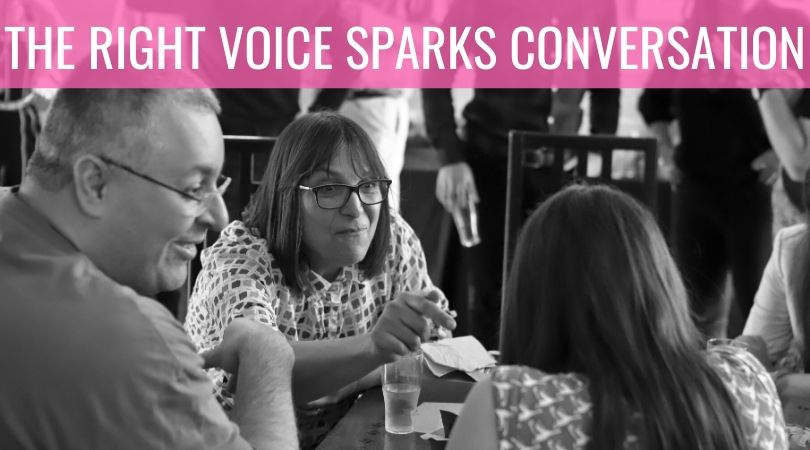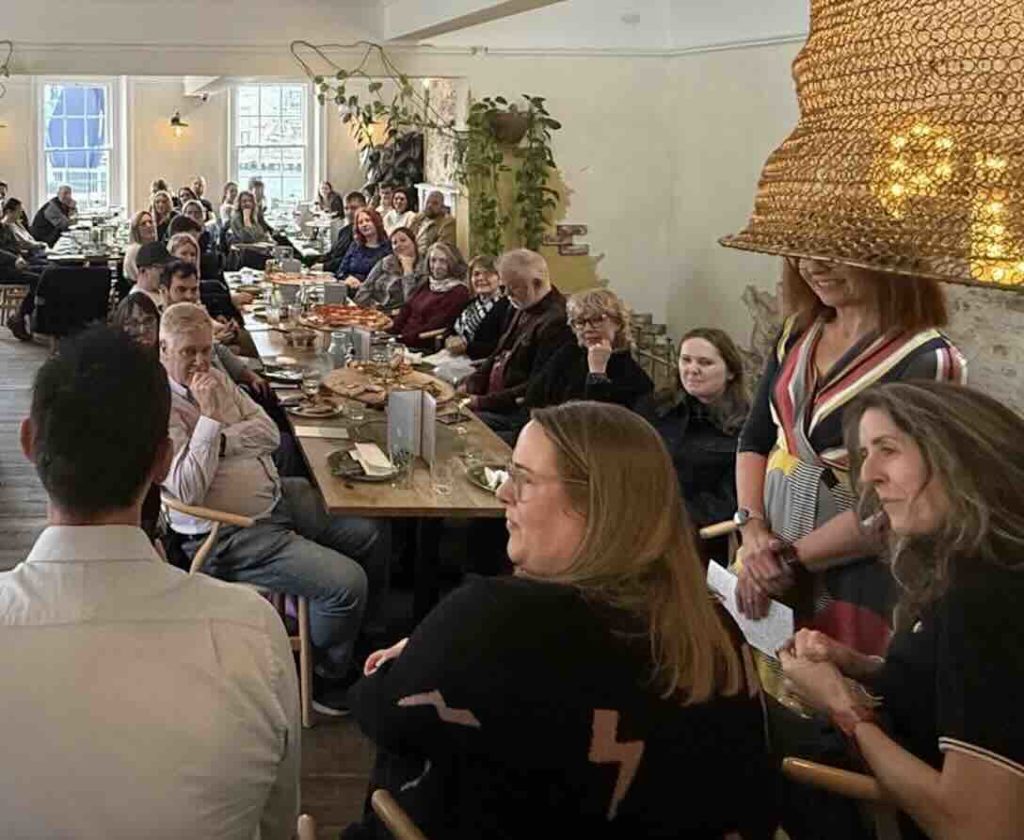Let’s learn and create together!
Book your placeHow The Right Voice Can Spark Conversation

Content that resonates with your audience and moves them to act is as much about “how” you’re saying something as it is about “what” you’re saying. The “how” is called tone of voice.
This article looks at how getting your tone of voice right can be a budget (and reputation) multiplier. Hat tip to Doug Kessler who was the headline guest at a recent You Are The Media Lunch Club Online and spoke about how powerful this can be.

Let’s get things clear from the start, tone of voice flows through all your written, broadcast or in-person communication. It’s there, saying something about what it’s like to do business with you, whether you’ve been intentional about how you want to appear, or not.
It represents a series of signals you send out to others who then decide if you’re right for them. And it takes far more thought and hard work than merely adding words like “human” or “collaborative” to a LinkedIn post.
The objective of creating a strong voice is to reflect who you are and bring the right people to you. As Doug said, this is “untapped potential that every company can tap into…but very few do.”
When you get your voice right:





Doug highlighted, “Confidence becomes the magnetic force to bring people to you.” This makes sense – people can see you’re good at, and enjoy what you do, which makes it easier for them to become attached to you. It feels less like hard work for them.
A Real Life And Personal Case Study
This is something I shared at the YATM Lunch Club Online:
In 2017, someone who I respect and spent time working with on my business turned to me and said that I “sounded like a w*****.” At the time, I was taken aback and stunned to hear my voice being described like that.
However, looking back now, it made complete sense. When it comes to voice, you have to be delivering in a way that invites people in and sparks connection rather than puts up walls. Let me explain what I was getting wrong back then:






If you want to see what I mean watch this, Margaret Magnarelli (our guest for today’s YATM Lunch Club Online) effectively carried me. Composed and considered – hers is the complete opposite of my tone (watch below).
Looking back now, I was delivering in a way that was distancing me from others rather than pulling them in. If I hadn’t taken that criticism on board, things could be very different today.
Voice In A Covid Place
Back to our time with Doug at YATM Lunch Club Online…I asked him what he’s picking up from business messages during the pandemic:
“There is no playbook for marketers on this. Some of us are getting it right and some aren’t. Many companies say they are there for us but are they really?”
Not every company has to be a part of this conversation. You probably aren’t going to notice too much that your energy provider says they care about you. On the opposite side, some companies are opening up and being honest with how they are adjusting to the changes.
Doug highlighted how being able to let your guard down and share your weaker points openly and honestly, putting across your personality and perspective, gives your voice strength and makes you believable.
After all, what would draw your attention, a company that displays a vulnerable side, or a company that wants you to know they are open for business?
Examples Of Great Personal & Organisational Tone Of Voice
Let me highlight two ends of the spectrum, the first on a localised level, the other in a big brand context.
Darren Slade is the business editor of the Bournemouth Echo and Southern Daily Echo. He shares the voices and perspectives of others in the business press, but at the same time his own tone of voice is what others have confidence in and many people rely on his perspective.
It’s not just what Darren writes but the consistency of his delivery – a tone of voice that is assured, matter of fact, honest and fittingly formal. He recognises the importance of connecting the business community to one another not just featuring individual stories, and shares a digest on everything he’s reported on at the end of each week.
This is reflected in him never being seen, during the pandemic, in anything other than his trademark shirt and tie. In fact even on the hottest day of 2019 that coincided with a YATM Lunch Club, Darren had a tie on.

I wanted to highlight Darren as he demonstrates what happens when you choose to ensure that everything you do reflects your character, position and delivery. He’s made choices about his voice. Where do you sit when it comes to your voice?
Thoughtful or funny?
Formal or relaxed?
Excited or matter of fact?
On a corporate level, although it’s quite a well-worn example, this represents a true definition of tone of voice hitting the mark: REI is a retailer specialising in the great outdoors. When Black Friday comes around, REI their doors and encourage customers and staff to explore the world around them rather than shop on this day. REI would rather be in the mountains, than in the aisles.
Their hashtag #OptOutside says everything about a tone of voice which cares deeply about living a full life, as well as the products they sell. They want people to align with their thinking and encourage customers to cherish the outdoors. There’s clarity in their actions and their message.
What You Can Be Thinking About & Apply
Finding your own true tone of voice and encouraging conversation takes time and plenty of thought. Here are some areas you might want to think about so that others find it easier to engage with you:
You don’t have to be perfect, it’s better to be honest.
Get comfortable with being open – it’s a position of far greater strength and relatability than the stiff upper lip that reveals nothing. A great example is Sonja Jefferson’s recent article, (People have noticed and reacted click here)
Be clear about who you are and what you’re not.
An accountancy firm whose primary aim is supporting its clients with their finances starts to look confused when it strays too far from home territory. Staying close to what you’re known for makes it easier for others to align with and remember you.
You are who you are, not who you might want to sound like.
You may love everything about the tone of the Innocent Drinks brand but it doesn’t mean you can, or should, become the B2B equivalent. It’s far better to develop your own voice, one that resonates with who you truly are. No one can take it away from you and very soon it starts to become your differentiator.
Remember how it feels to have a conversation in real life.
Just because you’re writing rather than speaking to your audience one-to-one, it doesn’t mean you have to become unapproachably formal and on high. You can help without dictating or driving your point home – an About Us page that is full of bluster and self-assurance doesn’t help anyone.
The more confident you become, the easier it is to be vulnerable.
Doug says, “Only a leader would admit how bad they are at something.” Being open about your own insecurities comes from a place of power. This is about being open in a way that others connect with, sparking conversations and sharing.
Let’s Round-Up
Your tone of voice is something that you have control of and that cannot be manufactured. It represents you and how you present yourself to everyone.
If you take out the technical word ‘tone of voice’, think of it as how you talk to everyone. Is it closed, is it open? Does it feel uptight, does it feel welcoming? It doesn’t matter if an industry behaves in a particular way, your company represents you and the people who are part of it.
Make what you share, accessible to those you want to reach. If people are going to make a decision to work with you, subscribe to you, buy from you, they’ll find every opportunity to ensure that the touchpoints they have all match up. This is your voice, in a conversation that brings people closer to you.
LET ME READ THE ARTICLE TO YOU, CLICK BELOW.
Podcast: Play in new window | Download

Build Your Community
A brand new programme from Mark Masters for businesses wanting to make that next growth step.
Find out moreYATM Club
Where non-conformist business owners come to work, learn and make friends. Click here

